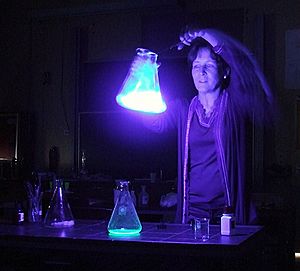Chemiluminescence facts for kids

Chemiluminescence (or Chemoluminescence) is a kind of luminescence. It is a process of making light from a chemical reaction. Chemiluminescence in biological systems is called bioluminescence.
The light made in chemiluminiscence is not directly related to heat. A simple two step example of a reaction of A, and B, that produces; C, D, and light.
- [A] + [B] → [C*] + [D]
- [C*] → [C] + Light
C* is an excited state of C.
This reaction is simpler than most chemiluminesence reactions. The excited state happens when electrons are pushed into a higher orbit by the energy of a chemical reaction. The excited state is less stable than the ground state. The electrons in the excited state fall to the ground state (lower energy), emitting light.
The amount of measurable light made is called radiant intensity: ICL (photons emitted per second).
Analytical applications
The device needed to measure the light made is simple. It needs something to hold the sample, and a photomultiplier tube. There are three ways for this to be used in chemical measurements.
- sometimes the product wanted makes light when it reacts with another compound,
- in another type the amount of light made drops when the wanted product is added,
- sometimes the wanted product when added to a chemiluminescence reaction makes more light(a catalytic reaction).
Other examples
- An example of chemiluminescence molecules in nature is firefly luciferin.
- The process is used to make glowsticks.
- Daniel C. Harris. In Quantitative Chemical Analysis Seventh Edition: 2007 by W.H. Freeman and Company.
- Douglas A. Skoog, James F. Holler, Stanley R. Crouch. In Principles of Instrumental Analysis Sixth Edition:2005 by Thomson, Brooks, Cole.
Images for kids
-
Bioluminescence in nature: A male firefly mating with a female of the species Lampyris noctiluca.
-
Chemiluminescence after a reaction of hydrogen peroxide and luminol
See also
 In Spanish: Quimioluminiscencia para niños
In Spanish: Quimioluminiscencia para niños




